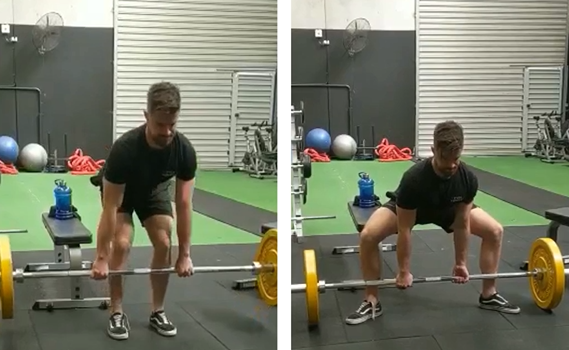Deadlift Variations:

CONVENTIONAL VS. SUMO
Conventional or sumo, what should you choose? What is lift allows the individual to lift more weight? What is even the difference between the two?
Anecdotally, I prefer the sumo stance. I have bounced between the two lifts for quite some time now. I like both lifts however I lean more towards the sumo variation as it just feels more comfortable, it is more stable at heavier weights and I am able to lift more weight. However, this is just my experience, this is not to say that conventional is not for you.
Let me run you through the two styles
The conventional stances require the individual to place their feet roughly shoulder width apart. Your feet should be pointing forward, or slightly rotated (if that feels more comfortable). When gripping the bar, you would place your hands just outside the knees. You’d have a slightly more bent over/forward lean from the torso in the conventional stance
When lifting sumo, you are required to open up your hips and place your feet as wide as possible. Your feet should be externally rotated. Ideally, the typical stance will be where your knees are still inline and above your heels. In terms of grip you would place your hands roughly shoulder width apart. Your torso is required to be more vertical during the sumo stance because of the how the hips are.
-------------------------------------------------------------------------------------------------------------------------------------------------------------------
The sumo stance can be perceived as the easier lift of the two given the reduced in total distance of the bar path. Research has validated this observation, the sumo stance has ~20-25% shorter range of motion compared to the conventional. Therefore, this implies that the conventional deadlift requires ~20-25% more mechanical work to overcome the lift.
So, after reading that, that the conventional seems to be the harder lift of the two to obtain a higher weight lifted. Seemingly it seems that way, but when you look at the people who are lifting at the elite level, the people who hold world records, the majority of them lift conventional – the “harder” of the two lifts. It largely comes down to personal preference and what movement you physically find yourself strongest in.
-------------------------------------------------------------------------------------------------------------------------------------------------------------------
Let’s start off with what the two variations have in common, as there is only one thing that the two lifts share.
Interestingly, the force production from the hips required between the two lifts are actually equal. This is due to the fact that there is no different in the hip extension moment arm length. Even despite the wider sumo stance there is no difference, no advantage when it comes to the hips.
-------------------------------------------------------------------------------------------------------------------------------------------------------------------
So what are the key differences between the two variations?
- During the sumo stance the quadriceps are activated to a higher degree. When the bar leaves the ground, specifically, the vastus lateralis and medialis are approximately working 3x more in the sumo stance compared to the conventional
- There will be less force placed upon the spine compared to a conventional deadlift. Researchers identified that there was a 10% greater demand placed upon the muscles required for spinal extension. This is due to the torso being in a far more inclined and forward posture.
-------------------------------------------------------------------------------------------------------------------------------------------------------------------
It has been reported by numerous professionals that deciding on the stance comes down to trial and error. One lift may feel better when compared to the other. So, try out both, spend a good couple training block on both of the lifts (e.g. 12 weeks), try out both lifts at your maximal, or near maximal load and see how it feels.
Feels more comfortable during your conventional at a higher intensity. Well, stick to it. You’ve evidently got stronger spinal erectors when compared to your quads as they can hold the load more comfortable, so continue with it and get strong at it.
Conversely, if you feel stronger and more comfortable performing the sumo then that’s the lift for you. Rock it and get strong at it. Lift that weight.
-------------------------------------------------------------------------------------------------------------------------------------------------------------------
References:
A three-dimensional biomechanical analysis of sumo and conventional style deadlifts.
Escamilla RF1, Francisco AC, Fleisig GS, Barrentine SW, Welch CM, Kayes AV, Speer KP, Andrews JR.
An electromyographic analysis of sumo and conventional style deadlifts.
Escamilla RF1, Francisco AC, Kayes AV, Speer KP, Moorman CT 3rd.
Lumbar spine loads during the lifting of extremely heavy weights.
Cholewicki J1, McGill SM, Norman RW.
